[From King William's College: Centenary
Notes & Pictures, 1933]
A DISTINGUISHED EARLY GROUP
The College Register for the
first fifteen years(1833-48) contains the names of a group of
O.K.W.'s distinguished for their work in Church and State.
|
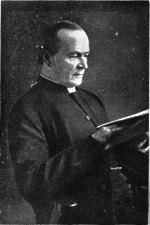
THE VEN. F. W. FARRAR, D.D.
|
F. W. Farrar (1839 47) was Head of the School and had a
distinguished career at Trinity College, Cambridge He was
Scholar and Fellow of Trinity; Chancellor's medallist; he
won the Hulsean and Le Bas Essay prizes and was placed
fourth in the first class, Classical Tripos, in 1854. He was
first an assistant master at Marlborough and later at
Harrow. He was Headmaster of Marlborough 1871-76; Canon and
Archdeacon of Westminster and Rector of St. Margaret's
1876-95;Chaplain to the House of Commons; the Chaplain and
Deputy-Clerk to the Closet to H.M. King Edward VII; Fellow
of the Royal Society; and became Dean of Canterbury in 1895,
where he died in 1903. His many writings included Eternal
Hope and The Life of Christ;but he is perhaps
best known at College - and elsewhere - as the author of one
of the first books on the Public Schools - Eric or
Little by Little;
|
|
The Rev. John Ellerton (1842-44) was not only a great
hymn writer but a great hymnologist. He had an exhaustive
knowledge, not only of Greek and Latin hymns, but of those
in most European languages. He contributed the article on
hymns in Smith's Dictionary of Antiquities. His own
compositions included " Saviour again to Thy dear Name we
raise "; " The day Thou gavest, Lord, is ended "; " This is
the day of light ";and " Now the labourer's task is
o'er."
|
|
T. E. Brown
(1846-49), the poet, whose centenary was celebrated in 1930,
is one of the greatest of our Manx old boys. He gained an
exhibition to Christ Church, Oxford, and took a first class
in Classics and a first in Law and History. He became a
Fellow of Oriel, and returned to K.W.C. as Vice-Principal in
1855. In 1861 he became Headmaster of the Crypt Grammar
School, Gloucester, and joined his friend J.
M. Wilson, also an O.K.W., and then Headmaster of
Clifton, as second master at Clifton in 1863. He died while
on a visit to Clifton, after his retirement, in 1897. His
place among the greater British poets is now secure. It is
his Manx poems which are most characteristic of the man, and
which enshrine the genius and natural philosophy of the Manx
people. He is commemorated by two side windows in the Chapel
erected in 1898, and also by a bronze tablet on the
wall.
|
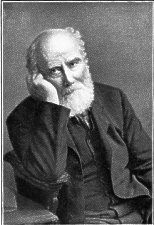
THE REV. T. F. BROWN.
|
|
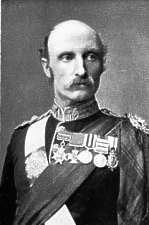
FIELD-MARSHAL SIR GEORGE WHITE, V.C.
|
Sir George Stewart White, V.C. (1847-50) is best known as
the defender of Ladysmith, during the South
African War, from and November, 1899, to 1st March,1900.
He saw wide service in the army in many parts of the world.
He was decorated with the V.C.in recognition of his
conspicuous bravery at Charasiab in1879. He held the orders
C.B., K.C.B., G.C.I.E., G.C.B.,G.C.S.I., G.C.M.G., and O.M.
He was Hon. LL.D. of Cambridge; D.C.L. Oxford; and LL.D.
Dublin. He was promoted Field-marshal in 1903. The service
jacket with its probably unique collection of medal
ribbons,which he wore during the siege of Ladysmith, was
presented to the College in 1932, and is in the Walker
Library.
|
|
The Rev. Thomas Fowler, D.D. Oxon, Hon. LL.D.(Edin.) (1848-49), was Postmaster of Morton College,Oxford; he was a
" double first " in Classics and Mathematics; Fellow of Lincoln; Denyer Theological Scholar. He served the University
as Proctor, Professor of Logic, and Select Preacher. He became President of Corpus Christi in 1881 and was Vice-Chancellor
of the University of Oxford 1899-1900. Dr. Fowler was born in Castletown [this would appear
to be incorrect - born 1st September 1832 at Burton Stather, Lincolnshire] and attended the College as a day
boy. He died at Oxford in 1904 and bequeathed to the Trustees an endowment of £1000 for the College.
|
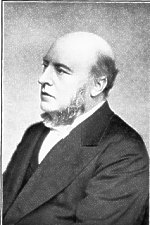
THE REV. T. FOWLER, D.D., LL.D.
|
Canon James Maurice Wilson, D.D. Camb. (184553), was a son of the first principal of the College,
the Rev. Edward Wilson. He was Head of the School andplayed for the XI. He became a scholar of St. John's College, Cambridge,
in 1855, and was Bell (University)Scholar, Senior Wrangler and Fellow of his College.Becoming an assistant master at Rugby
School in 1859,he was one of the first to develop scientific teaching in Public Schools. In 1879 he was appointed Headmasterof
Clifton College, and was there until 1890. Subsequently he was Vicar of Rochdale, Archdeacon of Manchester, and Canon of
Worcester and Vice-Dean of the Cathedral. He wrote a number of books on theological and scientific subjects, and was one
of the foremost interpreters of the scientific spirit in his age.He presented the pulpit in the College Chapel in memory
of his father. He died at the age of ninety-six in 1932.
|
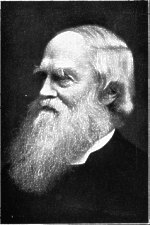
THE REV. CANON J. M. WILSON, D.D
|
|
THE REV. JOSHUA HUGHES-GAMES,D.C.L. Oxon, was Principal from 1866 to1886. Dr. Hughes-Games
had a distinguished career as a member of Lincoln College, Oxford. He gained a first class in Mathematics;was
Johnson (University) Mathematical Scholar and Senior Mathematical Scholar. Before coming to King William's College
he was Vice-Principal of the York Training College; and Headmaster of the Liverpool Institute. Dr. Hughes-Games
became Archdeacon of Man and Rector of Andreas in 1886. His principalship was marked by a large increase in
academic honours won by the College and also by considerable extension of the buildings, including a laboratory
for practical chemistry(1869); the gymnasium (1872); the new Chapel (1879);the Sanatorium (1882); Mr. Pleignier's
House (1884),later acquired by the Trustees for the Junior House;and the completion of the Entrance Hall (1886)
|
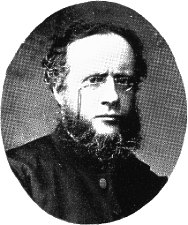
THE REV. J. HUGHES-GAMES, D.C.L.
|
|
|
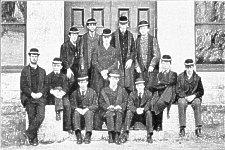
PRAEPOSITORS, 1880.
Bishop J. O. NASH Canon T. F. MADDRELL Rev. S. A. P. KERMODE
N. B. SKOTTOWE Archdeacon J. R. H. BECHER
Rev. H. F. FREEMAN Bishop C. H. GILL. T. A. LACE Canon J. M. WALKER L.
PLEIGNIER Archdeacon J. KEWLEY Rev. S. H. W. HUGHES-GAMES
|
THE CHAPEL
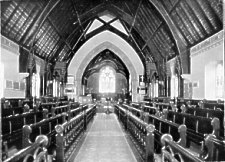
The original Chapel was, of course, on the ground floor of the Tower block
of the main buildings. It was transferred to the first floor in 1868. The present
Chapel was built in 1878, and was consecrated on 28th January, 1879. It was
perhaps unfortunate that the building was not properly orientated, and placed
beyond the main buildings at the East end. The fine stone pulpit was presented
by Canon J. M. Wilson in memory of his father, the first Principal. The oak
panels in the Chancel were the gift of P. B. Drinkwater, Esq. The oak stalls
for the Bishop, the Lieutenant-Governor and other trustees, and the tiles, were
provided by subscriptions raised by the Principal, the Rev. Dr. Hughes-Games,
from masters, pupils and friends. The lectern is the gift of several old boys.
Among the more recent additions to the Chapel are the memorials to T. E. Brown
; the Chancel windows, presented by the Rev. Canon J. M. Walker, D.D., and the
Book of Remembrance, presented by Major K. S. S. Henderson.
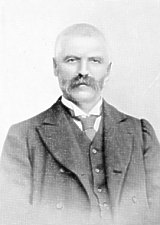
"PLAN" (1860-1906) [Victor Pleignier].
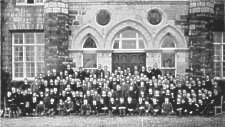
MASTERS AND BOYS, 1886.
The Rev. Frank Bridgman Walters, MA., Queens' College, Cambridge, 8th
Wrangler and Fellow of Queens', was Principal from 1886 to 1899. During
this period the main part of Principal's (now School House) was built and
opened (1888) ; the roof of the College was raised, giving five extra dormitories
(1892) ; the new organ was placed in
the Chapel, and the whole of the playing fields were levelled. In 1888 the
Swimming Bath was installed, at a time when there was only one other similar
bath in any school in the kingdom.
|
|

THE PRINTING PRESS, 1895. |

PLEIGNIER'S HOUSE (JUNIOR HOUSE). |
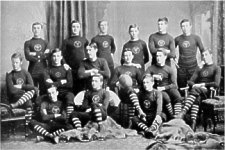
THE FIRST XV, 1883 (NOTE THE OLD CREST WITH THE " LEGS
OF MAN ").
Bottom Row-G. E. WRIGHT (Half-Back) C. E. HOYLE (Half-Back) S. W. C. HOWE (Forward)
Sitting-D. J. MCLEAN (Forward) C. J. S. ADAMS (Forward) A. H. PILKINGTON, Esq.
(Three-Quarter Back) T. H. M. GREEN (Forward), Gapt. W. S. HOYLE (Forward) T.
J. MURRAY-MENZIES (Forward) Standing-A. MITCHELL. (Forward) S. G. MITCHELL (Forward)
W. ST. Q. LENG (Full Back) F. M. B. HOBBS (Three-Quarter Back) C. G. RENDEL
(Forward) H. H. LA MOTHE (Three-Quarter Back)
S. MITCHELL and A. MITCHELL did not receive their caps, but played in the absence
of TRACY (Three-Quarter Back), JACKSON (Forward).













